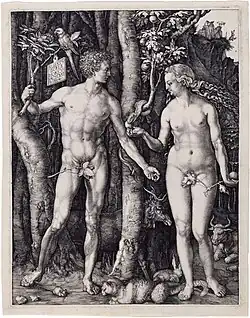| Part of a series on |
| Christianity and gender |
|---|
 "Adam and Eve" by Albrecht Dürer (1504) |
Biblical womanhood is a movement within evangelical Christianity, particularly in the United States. It adopts a complementarian or patriarchal view of gender roles, and emphasizes passages such as Titus 2 in describing what Christian women should be like. According to Rachel Held Evans, it is driven by the conviction that "the virtuous woman serves primarily from the home as a submissive wife, diligent homemaker, and loving mother."[1]
Institutions supporting the movement include Southern Baptist Theological Seminary and Southwestern Baptist Theological Seminary,[2][3] while organizations associated with the movement include the Council on Biblical Manhood and Womanhood. Notable writers include Nancy Leigh DeMoss, Susan Hunt, Mary Kassian, Carolyn Mahaney, Dorothy Patterson, Elisabeth Elliot, and Priscilla Shirer. Edith Schaeffer's 1971 book, The Hidden Art of Homemaking, has been described as "perhaps unintentionally, a landmark book for proponents of biblical womanhood."[4]
Rachel Held Evans suggests that "biblical" is a loaded term, and argues that adherents have "refused to acknowledge" that their interpretation involves a "certain degree of selectivity".[5][6][7] Advocates caution that "most women in Third World countries... would find our American, evangelical stereotype of biblical womanhood completely foreign and often simply physically impossible."[8] Some conservative Christian women have critiqued Evans's interpretation for undermining faith in biblical inerrancy.[9]
In 2010, Molly Worthen wrote that "'Biblical womanhood' is a tightrope walk between the fiats of old-time religion and the facts of modern culture, and evangelicals themselves do not know where it might lead."[10]
See also
References
- ↑ Evans, Rachel Held (2012). A Year of Biblical Womanhood: How a Liberated Woman Found Herself Sitting on Her Roof, Covering Her Head, and Calling Her Husband "Master". p. xix. ISBN 9781595553676. Retrieved 27 July 2015.
- ↑ Allen, Bob (31 March 2014). "Seminary website lists aspects of 'biblical womanhood'". Baptist News Global. Retrieved 27 July 2015.
- ↑ "Who We Are". BiblicalWoman. Southwestern Baptist Theological Seminary. Retrieved 27 July 2015.
- ↑ Joyce, Kathryn (2009). Quiverfull: Inside the Christian Patriarchy Movement. Beacon Press. p. 42. ISBN 9780807010709. Retrieved 27 July 2015.
- ↑ Evans, Rachel Held. ""Biblical Womanhood" and the illusion of clarity: a response to Kathy Keller". Retrieved 27 July 2015.
- ↑ Dalfonzo, Gina. "Rachel Held Evans and the true meaning of 'biblical womanhood'". BreakPoint. Retrieved 27 July 2015.
- ↑ Barrick, Audrey (13 November 2012). "'Year of Biblical Womanhood' Draws Criticism From Complementarian Women". The Christian Post. Retrieved 27 July 2015.
- ↑ Alsup, Wendy (23 February 2014). "Biblical Womanhood and the Pariahs of the Church". CharismaNews. Retrieved 27 July 2015.
- ↑ "A Year of Biblical Womanhood: A Review". Desiring God. 2012-10-08. Retrieved 2019-04-27.
- ↑ Worthen, Molly (12 November 2010). "Housewives of God". New York Times Magazine. Retrieved 27 July 2015.